
Vacuum Valve Function
The vacuum valve has the following characteristics:
The pressure is lower than atmospheric pressure, and the pressure drop on the disc must not exceed 1 kgf / cm2. The operating temperature of the medium depends on the process in which the device is used. The temperature generally does not exceed the range of -70 ~ + 150 ° C. The basic requirements for this type of valve are to ensure a high degree of tightness in the connection and the tightness of the structure and gasket material. Vacuum valves can be divided into four groups according to media pressure:
1) Low vacuum valve: medium pressure p = 760 ~ 1mmHg;
2) Medium vacuum valve: p = 1 × 10-3 mm Hg.
3) High vacuum valve: p = 1 × 10-4 ~ 1 × 10-7 mm Hg;
4) Ultra-high vacuum valve: p≤1 × 10-8 mm Hg.
Vacuum valve widely used in the valve stem for linear motion of vacuum bellows globe valve. Gate valves are more limited, but for larger diameters, ball valves, plunger valves and butterfly valves are also available. Plug valves for vacuum valves have not been promoted, because the plug valves need to be lubricated with oil, so that oil vapor may enter the vacuum system, which is not allowed. Vacuum valve closures are sealed with rubber or metal seals. The bellows of the bellows globe valve are made of stainless steel, high zinc brass JI80, plastic and other materials. Small-diameter (diameter below 10 mm) globe valve closures can be sealed with a diaphragm. Low and medium vacuum can use spherical plug valves.
The vacuum valve has the following characteristics:
The pressure is lower than atmospheric pressure, and the pressure drop on the disc must not exceed 1 kgf / cm2. The operating temperature of the medium depends on the process in which the device is used. The temperature generally does not exceed the range of -70 ~ + 150 ° C. The main valves of Shanghai Shenhong Valve Co., Ltd. are: pressure reducing valve (gas pressure reducing valve, adjustable pressure reducing valve, bellows reducing valve, piston reducing valve, steam reducing valve, pilot reducing valve, air Pressure reducing valve, nitrogen pressure reducing valve, water pressure reducing valve, self-operated pressure reducing valve, proportional pressure reducing valve), safety valve, thermal insulation valve, cryogenic valve, ball valve, globe valve, gate valve, check valve, butterfly valve, filter Device, discharge valve, diaphragm valve, plug valve, plunger valve, balance valve, regulating valve, trap valve, pipe clamp valve, blow down valve, exhaust valve, mud discharge valve, pneumatic valve, electric valve, high pressure valve, medium Pressure valve, low pressure valve, hydraulic control valve, vacuum valve, rubber lined valve, fluorine lined valve. The basic requirements for this type of valve are to ensure a high degree of tightness in the connection and the tightness of the structure and gasket material.
Vacuum valve widely used in the valve stem for linear motion of vacuum bellows globe valve. Gate valves are more limited, but for larger diameters, ball valves, plunger valves and butterfly valves are also available. Plug valves for vacuum valves have not been promoted, because the plug valves need to be lubricated with oil, so that oil vapor may enter the vacuum system, which is not allowed.
Vacuum valve closures are sealed with rubber or metal seals. The bellows of the bellows globe valve are made of stainless steel, high zinc brass JI80, plastic and other materials. Small-diameter (diameter below 10 mm) globe valve closures can be sealed with a diaphragm. Low and medium vacuum can use spherical plug valves.
The vacuum valve has the following characteristics: The pressure is lower than atmospheric pressure, and the pressure drop on the disc must not exceed 1 kgf / cm2. The operating temperature of the medium depends on the process in which the device is used. The temperature generally does not exceed the range of -70 ~ + 150 ° C. The basic requirements for this type of valve are to ensure a high degree of tightness in the connection and the tightness of the structure and gasket material.
Vacuum valve function
The rate is the amount of gas that flows under low pressure (or high concentration) under specified conditions to the low pressure end (or low concentration end) through the leak in a unit time. It is divided into dynamic leakage rate and static leakage rate. The pressure increase rate is determined by measuring the pressure value that increases with time after the pumped container is isolated from the vacuum pump, which is a static concept. In addition to the leakage rate of gas that penetrates into the equipment through the welds, seals, and material body, the pressure increase rate also includes the desorption of the adsorbed gas and the vapor pressure of other substances (such as oil and grease) inside the equipment. Therefore, the two concepts are different. The leak rate is included in the boost rate, and its value is only a part of the boost rate. In the actual measurement process, the boost rate is often used for detection, and the boost rate is multiplied with the measured volume as the leak rate. .






